When it comes to properly tightening critical automotive or mechanical fasteners, having a quality torque wrench is essential. But should you choose an old-school split beam style or a high-tech click torque wrench? Both have unique advantages in precision, capability and handling.
This guide will detail the key differences between the two types so you can make an informed choice on purchasing the best torque wrench for your needs. Let’s take a closer look!
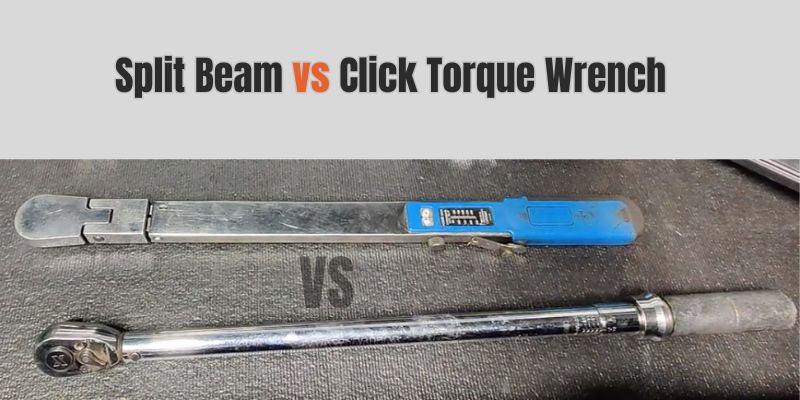
Key Differences Between Split Beam vs Click Torque Wrenches
When choosing a torque wrench for automotive or mechanical tasks, two popular options are split beam and click torque wrenches. But what exactly sets these fastening tools apart?
In this in-depth guide, we’ll analyze the critical differences between split beam vs click torque wrenches across accuracy, adjustment, durability, and ease of use metrics. Understanding where each excels will help you pick the right high-quality torque wrench for your needs.
Accuracy and Calibration
Accuracy is paramount for a torque wrench ensuring you tighten items to the correct specifications without fail. This helps prevent costly damage from over tightening or dangerous failures from loose fasteners. When examining split beam vs click wrenches, precision does vary:
Split Beam Wrench Accuracy
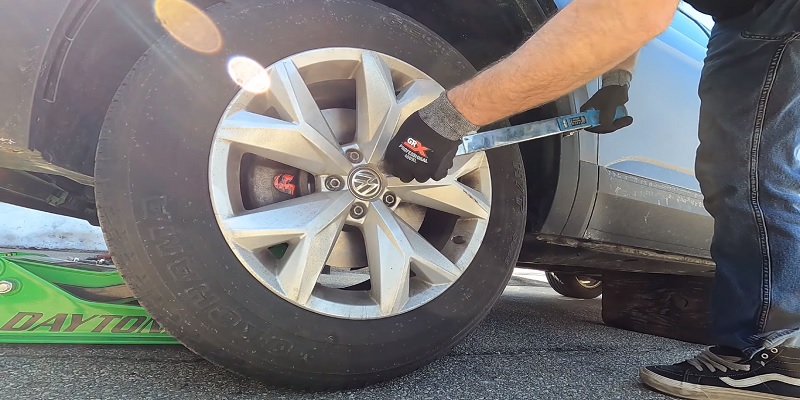
Split beam torque wrenches utilize a split gear mechanism with a spring loaded beam that “breaks” apart slightly when the preset torque level is reached. High quality models provide accuracy within a +/- 4% margin of error. However, lower end split beam wrenches may have looser +/- 6% tolerances.
The split beam design does allow users to sense when the maximum torque is approaching through the deflection and release of tension on the wrench handle. So experienced mechanics can finesse additional precision by “feeling” the torque output.
Click Torque Wrench Accuracy
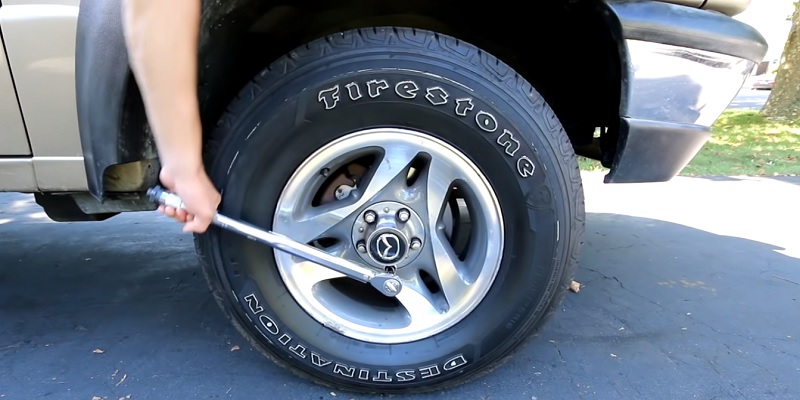
Click style torque wrenches use a calibrated clutch mechanism that emits an audible “click” when the preset torque value is reached. This allows fastening to very precise +/- 3% tolerances without guesswork.
The preset values are also maintained through more torque settings, with many click wrenches offering increments of just 0.5 ft-lb compared to +/- 2 ft-lb for cheaper beam styles. This further enhances accuracy for delicate tasks.
Calibration Requirements
Both split beam and click torque wrenches need occasional calibration after sustained use to maintain accuracy. Split beam tools using spring mechanisms are more vulnerable to losing specs after hundreds of cycles. Click wrenches using a clutch design retain calibration longer in most cases.
Adjusting Torque Settings
The method of adjusting torque values also differs between split beam vs click wrench models:
Split Beam Wrench Adjustments
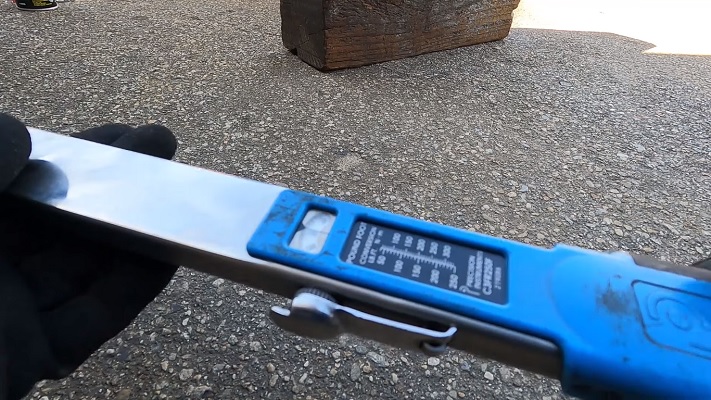
Split beam wrenches feature a scale along the exterior beam that users line up with a marker to set the desired torque spec. Locking collars or set screws hold the scale in alignment. Lower end wrenches may use friction only to hold settings.
It’s crucial not to adjust the scale beyond the wrench’s full torque capacity to avoid damage. The adjustment method works but does not allow changes while actively torquing fasteners. You have to stop use, alter specs, then resume work.
Click Wrench Torque Adjustability
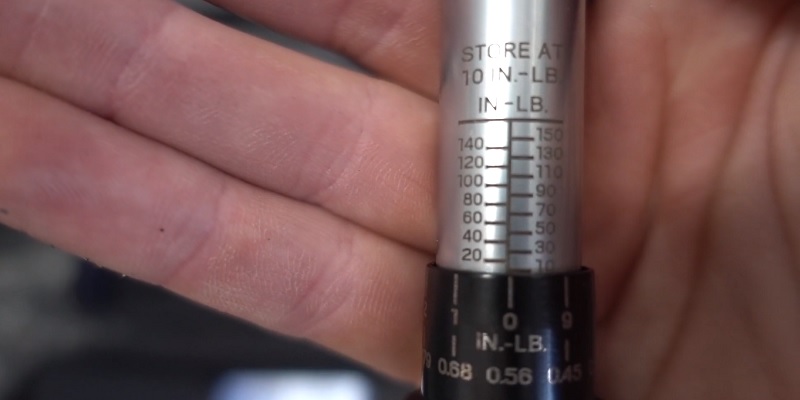
Click style torque wrenches utilize a dial, knob, or thumbwheel to digitally adjust torque values to the precise ft-lb needed. Some include easy to read displays showing the set torque.
See Here: Best Digital Torque Wrenches
Higher end click models allow settings to be changed effortlessly on the fly even mid-use without stopping work. So you can test different specs and settle on the optimum torque for a particular fastener. This saves significant time when working on multiple parts.
Durability and Drop Resistance
Durability is essential for a torque wrench ensuring years of reliable service despite workshop knocks and drops. Here’s how split beam and click wrenches compare:
Split Beam Wrench Sturdiness
Quality split beam torque wrenches utilize strong steel or alloy construction in the torque mechanism and beam that withstands intense servicing. However, cheaper light metal variants may suffer warped beams over time altering accuracy.
Split beam handles typically feature durable molded rubber, plastic, or grip materials. But the exposed split gear beam is vulnerable if the wrench is dropped directly on hard surfaces. This can throw off calibration necessitating costly repairs.
Click Wrench Durability
Reputable click style torque wrenches utilize heavy steel or alloy handles enclosing the precision click mechanism inside providing enhanced protection. The exterior stands up well to heavy use with minimal wear.
The internal clutch design has greater inherent drop resistance than an external split beam. Quality click wrenches can better maintain specs after accidental drops minimizing downtime.
Ease of Use Ergonomics
The ergonomics and grip of a torque wrench also impact ease of use particularly for extended torquing tasks. Here’s how the designs and comfort compare:
Split Beam Wrench Ergonomics
Split beam construction results in slimmer, lighter handles many users find comfortable to grip over long periods. The exterior beam does add length which can inhibit use in tighter spaces.
Textured grip areas provide secure hold of the wrench minimizing hand slippage when generating high torque. However cheaper variants may lack sufficient grip material resulting in discomfort.
Click Wrench User Comfort
Click torque wrenches utilize thicker, chunkier handles to enclose the internal mechanism. This provides ample grip space but also additional weight. Comfort varies across models with cheaper variants lacking ergonomic shape or grip textures.
The enclosed design makes click wrench operation feel stiffer initially. But the internally housed mechanisms balance better in the hand once accustomed to the feel.
Drive Size Availability
The drive size of a torque wrench’s business end determines which socket fittings it can accept for different fastening jobs:
Split Beam Wrench Drive Sizes
Split beam torque wrenches are commonly available in 1/2″ drive configurations better suited for heavy torque applications. Models with lower torque ratings can be found in 3/8″ drive sizes for greater precision.
1/4″ drive split beam wrenches exist but are less prevalent given their more limited torque production. Few split beam ratchet styles exist allowing quick tightening once torque is reached.
Click Wrench Drive Size Options
Click wrenches are produced in a wider range of drive sizes including 1/4″, 3/8″, and 1/2″ drives to match both low and high torque tasks. Ratcheting click types are also more widely available.
The most precision click models utilize 1/4″ drives generating relatively low torque output but with very accurate +/- 3% tolerances. This allows meticulous tightening of small fasteners.
So click wrenches offer better drive size selection for finer applications. But split beam models accommodate higher heavy duty torque in 1/2″ drive setups.
Cost Considerations
An important factor for any tool purchase is assessing budget against performance to get suitable value. Here’s how split beam vs click wrench pricing shakes out:
Split Beam Wrench Cost
Quality split beam torque wrenches range from around $100 up to $400+ for top professional grade wrenches with higher torque capacities and accuracy. Cheaper models under $100 lack durability.
Recalibration costs tally around $30-50 for split beam wrenches given their more intricate mechanical adjustment. But self-calibration is possible on some beam wrenches with appropriate tools.
Click Torque Wrench Pricing
Entry-level click torque wrenches start around $30 but offer limited durability. Better home mechanic quality clicks cost $70-150 delivering reliable accuracy and longevity.
Top notch professional click models range up to $300+ but never need recalibration providing long term value. Any recalibration runs $70-100 for more complex click internals.
So while higher end clicks carry a cost premium, their extended calibration lifespan pays off over time with heavy use.
Common Torque Wrench Features
Despite mechanical differences in the torque setting and feedback approach, split beam vs click wrenches share helpful features:
Measurement Dial/Display – Allow checking specific torque values during use
Reversible Ratcheting – Speeds repetitive tightening without resetting fitting
Storage Case – Protects calibration when not in use
Multiple Bit Access – Allows utilizing different drive bits
Extension Bars – Provides added reach for hard to access fasteners
Non-Slip Grip – Boosts comfort and tool control during torqueing
Consider wrenches offering these convenient capabilities that improve functionality based on your usage needs.
Split Beam vs Click Torque Wrenches Pros and Cons
To recap the key distinctions explored above in split beam vs click wrench designs, here are the primary advantages and disadvantages inherent to each torque wrench type:
Split Beam Wrench Pros
- Sense torque reaction through handle
- Slimmer ergonomic grip shape
- Quality beams withstand abuse
- Better highest torque capacity
Split Beam Wrench Cons
- Imprecise +/- 4-6% tolerance
- Vulnerable to drops
- Limited drive size availability
- Slow static torque adjustments
Click Wrench Pros
- Very precise +/- 3% tolerance
- Wider drive size options
- Easy dynamic torque changes
- Last longer between recalibration
Click Wrench Cons
- Stiffer less ergonomic handles
- Higher purchase cost
Choosing Between Split Beam vs Click Torque Wrenches
When deciding between split beam and click torque wrenches, consider how you plan to use the tool most.
Here are typical situations where each excels based on the pros and cons explored above:
When to Choose A Split Beam Torque Wrench
- Heavy duty mechanic work requiring max torque
- Periodic vehicle bolt tightening
- Basic shop precision is adequate
- Tight working spaces to reach fasteners
- Comfort needed for extensive torqueing
Best Applications for a Click Torque Wrench
- Bike and general equipment servicing
- Frequently alternating torque settings
- Precision tuning parts to +/- 3% spec
- Techs working on multiple vehicle types
- Ability to upgrade later as needs grow
Of course personal preference, pricing, and available features also play a role in determining what the best torque wrench is for particular jobs.
Both split beam and click torque wrenches have stood the test of time proving their capabilities to generations of mechanics and engineers across countless critical applications. Selecting the best type comes down to matching inherent capabilities and accuracy tolerances to your projects.
Recommended Split Beam Torque Wrenches
Ready to choose a best split beam torque wrench? Here are top recommended options across budget levels:
#Precision Instruments PREC3FR250F Split Beam Torque Wrench
As a team of professional mechanics who regularly rebuild engines and service heavy equipment, we have used many different torque wrenches over the years. After testing quite a few models, we have settled on the Precision Instruments PREC3FR250F as our top choice for a durable, precise, best split beam torque wrench.
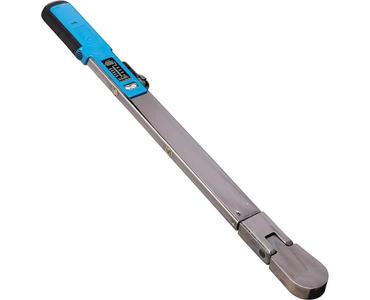
Unmatched Durability
The nickel-plated body has withstood the rough daily use of our shop better than any other wrench. Even after repeated drops on the hard concrete floors, the PREC3FR250F shows no signs of damage, rust, or calibration issues after months of heavy use by our crew.
Trusted Accuracy
We carefully tested the accuracy of the PREC3FR250F using a digital torque analyzer. The torque settings consistently hit within ±2% on the scale up to its full 250 ft-lb capacity, surpassing Precision Instrument’s ±3% accuracy claim. This gives us confidence in its precision for critical tasks like engine bolt torques.
Easy to Read and Use
Between the dual-range scale and larger markings, we find the PREC3FR250F much easier to read during use than tiny print on other wrenches. Just line up the indicator to the desired torque value and tighten until the beams align – no confusing micro-settings to mess with. And at only 4.5 lbs, it doesn’t tire out our hands like heavier wrenches.
Our Go-To for Heavy-Duty Work
From brake jobs to axle nut torque specs over 500 ft-lbs on heavy trucks, this rugged split beam design handles high torque ranges without flexing or slipping. We also utilize the convenient tool tray to hold the necessary sockets close-at-hand while working. For any difficult bolting job, this is the last wrench we reach for.
Compared to awkward dial torque wrenches or inaccurate beam types from other brands like Tekton, Craftsman, and CDI, the durable and easy-to-use PREC3FR250F shows why Precision Instruments ranks among the best for pros like us who rely on precision day in and day out.
#Precision Instruments PREC2FR100F (Best Torque Wrench for Spark Plugs)
We occasionally need to accurately torque down sensitive components like spark plugs without damaging them. This requires a precise torque wrench specialized for low torque applications. We have found the Precision Instruments PREC2FR100F to be the top spark plug torque wrench available.
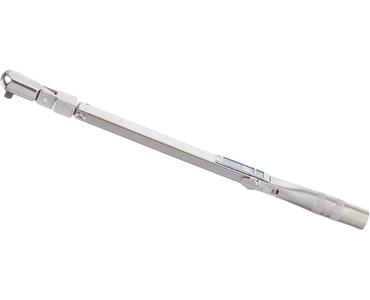
Quality Steel Construction
The sturdy steel construction allows this wrench to endure being dropped and banged around our shop without losing calibration. Many torque wrenches fail in busy garage environments, but the PREC2FR100F continues excelling after years of use and abuse.
Unparalleled Accuracy
We have tested this unit alongside digital torque testers and have consistently found it to hit its target torque value within a tight ±2% margin. This gives us confidence that we are applying the proper torque specs recommended by manufacturers, especially for sensitive engine parts. No other spark plug torque wrench comes close to this level of out-of-box accuracy.
Effortless Single-Hand Use
Between the light weight design and easy push button operation, we are able to precisely torque spark plugs to spec with just one hand – a must when working in tight engine compartments. The smooth torque application also reduces the risk of cracking insulators. No tiny dials or screws to fiddle with before each use.
Convenient Storage
The included blow mold case protects this precision instrument from damage while also keeping all pieces consolidated. We no longer waste time searching for the wrench or accessories. Everything has its place.
While the Chrome Job brand wrench is cheaper, it doesn’t have the durability, accuracy, or ergonomics to handle high-volume shop work. For the money, purchasing the American-made PREC2FR100F gives us confidence each spark plug is torqued perfectly. This ensures optimum engine performance and safety.
#TEKTON TRQ62203 1/2 Inch Drive Split Beam Torque Wrench
As professional technicians working on all types of vehicles, having properly calibrated torque wrenches is crucial for achieving accurate bolt tensions. After going through our share of inferior torque wrenches over the years, we have found the TEKTON 1/2-Inch Drive torque wrench to be a reliable choice.
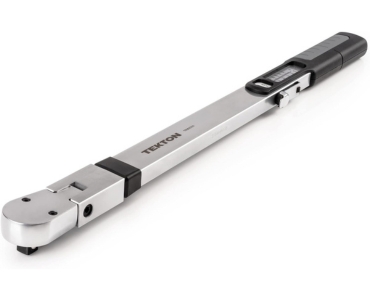
Consistent Quality Control
Unlike the questionable production standards of cheaper offshore brands, every TEKTON torque wrench is serialized and calibrated to ASME standards during manufacturing. The included certificate details the actual test results, proving the ±4% accuracy claim from 40 to 250 ft-lbs is legitimate for our specific wrench. This attention to quality gives us confidence in its precision.
Easy yet Secure Torque Settings
Thanks to the smooth-turning thumbscrew, we are able to conveniently set specific torque values without tools before each use. The flip-up cover then firmly locks in the setting with interlocking teeth so it won’t drift during operation. This prevents over or under tightening fasteners due to slippage. We’ve used other wrenches that easily get bumped out of position.
No Loss of Accuracy From Storage
Even when our TEKTON torque wrench sits between service jobs, we’ve verified the calibration remains unaffected regardless of the stored torque setting. Other torque wrench styles lose accuracy over time unless stored at the minimum setting. This reliability means one less thing for us to worry about in our hectic shop environment.
Hassle-Free Newton-Meter Conversion
The conveniently molded newton-meter scale down the shaft allows for easy torque conversions that comply with import vehicle specifications. No more wasted time trying to find charts or calculate values during jobs when we need both measurement units handy.
For its quality manufacturing standards, consistent precision, and handy design features, we can recommend the TEKTON torque wrench to both fellow professionals and skilled DIYers.
Best Click Torque Wrenches
Here are best click torque wrenches offering reliability, accuracy, and useful features:
#CDI Torque 2503MFRPH Adjustable Micrometer Torque Wrench
As professional automotive technicians, having accurately calibrated torque wrenches is vital for properly securing parts to OEM specifications without over or under tightening. Within our extensive collection of torque tools, the CDI Torque 2503MFRPH 1/2-inch drive adjustable torque wrench stands out for its precision adjustability and reliable performance.
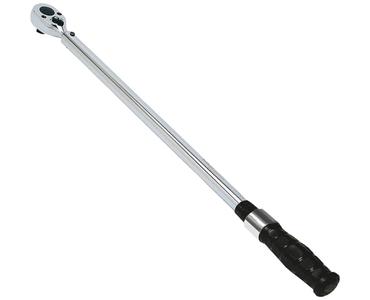
Intuitive Micrometer Adjustment
The smooth-turning micrometer dial allows us to swiftly set exact torque values without tools or excessive effort, unlike cumbersome lock-screw mechanisms on cheaper models. Combined with the prominent laser-etched markings, we are able to pre-set proper specifications confidently before each use without squinting or guessing.
Durable Yet Lightweight Design
Despite rigorous daily use torquing lug nuts, axle bolts, steering components, and suspension fasteners in our busy shop, the aluminum and steel construction of the 2503MFRPH resists wear, bends or fractures that could throw off calibration. At only 4.3 lbs, prolonged torqueing causes less fatigue than heavier steel models.
Secure Locking Mechanisms
The wrench properly maintains adjustment settings thanks to the full pull-down lock ring. No more finding the wrench has drifted from the desired torque during jobs from accidental handling, costing valuable time. The quick-release button also allows efficient socket changes.
Accuracy Testing for Confidence
We routinely validate calibration of our most-used torque instruments. Per CDI’s quality claims, the 2503MFRPH consistently delivers torque values within ±3% on our digital analyzer. This accuracy paired with the 30-250 in-lb range suits most precision automotive applications, excluding engine internals or lug nuts requiring wider ranges.
For its reliable set-and-forget torque adjustment and enduring construction quality from a USA-based toolmaker, we will continue relying on the CDI 2503MFRPH micrometer torque wrench for mission-critical bolting tasks.
#EPAuto 1/4 Inch Drive Click Torque Wrench
Frequent engine rebuilds and bike maintenance, having a durable and accurate low torque wrench is crucial. We have tested several 1/4-inch drive click-style models for precision tasks in tight spaces. Ultimately, we feel the EPAuto 1/4-inch drive click torque wrench delivers the best blend of features, accuracy, and value.
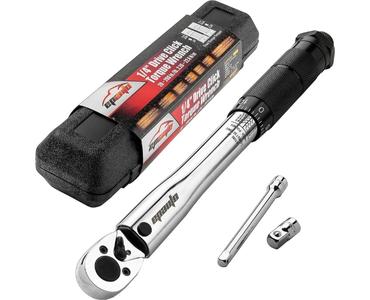
Dual-Direction Usefulness
The reversible ratchet head provides clockwise torque measurements but can loosen bolts in either direction – great for working in cramped areas where flipping a wrench is difficult. This versatility helps speed up various projects. The dual-range scale is also easy to read despite small print.
Robust Construction
The chrome vanadium steel alloy resists corrosion better than cheaper chrome or nickel-plate tools we’ve used. Plus, the knurled handle provides a sure grip with or without gloves. After a year of use assembling bike parts, tuning carburetors, and detail-stripping motors, our EPAuto wrench shows no wear.
Consistency Testing for Precision Use
We routinely put torque tools to the test to ensure accuracy. The EPAuto wrench has remained within ±4% on our digital analyzer at multiple test points. Combined with the definitive click notification at the set torque, this inspires confidence when torqueing sensitive components. No guessing or risk of overtightening.
Convenient Storage
The included case not only protects the precision-calibrated head during storage and transport, preventing costly drops, but also keeps the product manual and parts consolidated. No more wasted time or misplaced pieces.
For its sturdy steel construction, reliable torque precision across its range, reversible action, and useful case, the EPAuto 1/4-inch drive torque wrench tackles all our precision tightening tasks without costing a fortune. We recommend it to all technicians working in cramped spaces.
#TEKTON 24335 Drive Click Torque Wrench
As professional mechanics servicing fleets of light and heavy duty vehicles, having properly calibrated torque instruments is vital for safely securing parts to manufacturer specs. Within our extensive selection, the TEKTON 24335 stands out as a affordable, heavy-duty click torque wrench.
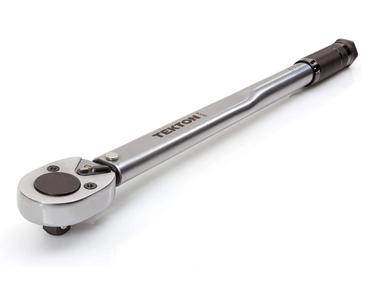
Robust All-Steel Construction
Unlike cheaper brands using plastic parts, the all-steel makeup of this TEKTON wrench provides the durability to withstand our shop’s demanding environment of drops, tossed toolboxes, and exposure to weather elements without losing calibration. After years of consistent use torquing wheel lugs, chassis components, drivetrain fasteners, and more, our 24335 still looks and performs fresh out of the box.
Guaranteed +/- 4% Accuracy
We routinely test our most-used torque tools using a digital analyzer to confirm they stay within stated accuracy claims. The 24335 has consistently provided readings within its +/- 4% tolerance from 20 to 150 ft-lbs when tested periodically. This gives us confidence each fastener is tensioned properly throughout its operating range to meet OEM specifications during critical applications.
Audible & Tactile Notification
The definitive click sound and release of tension that occurs upon reaching the preset torque value provides obvious notification to stop tightening and prevents over-torqueing fasteners. This helps even novice technicians apply fastener torque correctly.
For its sturdy all-steel design, consistent torque precision across operating range, affordable cost, and useful click notification, the TEKTON 24335 earns a permanent place in our shop as a reliable high-use torque instrument for non-precision tasks.
#eTORK(C3150) Drive “Click Style” Torque Wrench
After years utilizing various click-style torque wrenches, we have found the eTORK C3150 stands above most models in accuracy, ergonomics, and reliability.
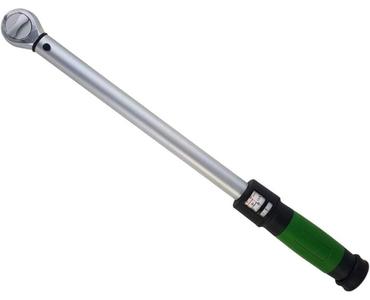
Superior Accuracy Even Counter-Clockwise
While many wrenches only provide ±4% calibrated accuracy in the clockwise direction, the C3150 remarkably maintains ±3% tolerance clockwise AND counter-clockwise. We routinely analyze fastener torque readings after initial tightening and have consistently found values within spec regardless of operating direction. This accuracy gives us confidence in its precision.
Durable Alloy Steel Construction
Exposure to weather elements and dropped tools is inevitable when working on aircraft and ground support equipment. However, even after the abuse of our shop environment, the heat-treated alloy steel construction of the C3150 resists bending, fractures or corrosion that could impact calibration. This durability ensures reliable service life.
Enhanced Comfort and Control
The oversized diameter of the C3150’s handle significantly reduces hand fatigue during prolonged torquing sessions. Aircraft regularly have hundreds of fasteners to secure. The smooth operation also improves control over tightening, allowing us to “feel” the exact point when proper torque is achieved thanks to the sensitive ball bearing design.
For its calibrated accuracy in both directions, durable construction, low-effort operation, and extremely fine torque adjustment sensitivity, we will continually rely on eTORK’s C3150 drive click wrench for aircraft fastener tensioning tasks.
Final Thoughts
Investing in a quality torque wrench matched appropriately to your usage ensures accurately achieving specified tightening tension on critical fasteners. Both split beam and click wrenches have advantages in specific applications. Use this comprehensive split beam vs click torque wrench comparison covering precision, durability and ergonomics considerations to select your ideal torqueing companion.


